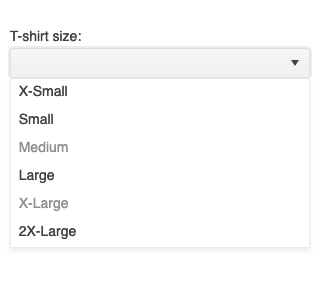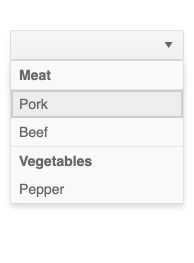
KendoReact
Free React DropDownList
- Enable users to choose a single item from a list of predefined options.
- Part of the KendoReact library along with 120+ free and paid enterprise-grade UI components.
- You can use this component’s free feature set in production—no sign-up or license required!

The KendoReact DropDownList has both free and premium features. The free features are sufficient to implement essential functionality in a production app.
-
Enable Users to Select a Single Item From a Predefined List
The KendoReact DropDownList component is a form component that enables end users to choose a single predefined value from a list, without support for typing in values, and is a richer form of the select element. Unlike other similar dropdown components, the React DropDownList does not include an input element that can be used for typing a value, and instead, can only be updated by selecting an option from the available list of data.

-
Data and Value Binding
The KendoReact DropDownList can be bound to various forms of data, including datasets of objects, an array of primitive values or binding directly to a single value property. Additionally, the React DropDownList can bind separate fields to the displayed text and the underlying value.
-
Default Item
By Default, the KendoReact DropDownList will render an empty area if no value has been displayed. Some requirements may call for some sort of placeholder string indicating what the DropDownList component is for, which is where the default item feature comes in. By setting this property, a custom string will be displayed in the React DropDownList when no item is selected.

-
Filtering
The built-in filtering mechanism of the KendoReact DropDownList automatically reduces the number of available choices in the DropDownList data list. Rather than displaying in the input of the React component, the filter appears as a search box at the top of the drop down. Filtering can be configured in various ways, including "starts with" or "contains" to ensure the most intuitive filtering behavior for any scenario.

-
Disabled Items
You have the flexibility to disable certain items within the React DropDownList. Once an item is disabled, it cannot be selected as a value for the component, but it might still remain focusable or non-focusable when navigating through the items using the keyboard.

-
Custom Rendering
Out of the box, the KendoReact ComboBox renders items as plain text. For requirements that need more intricate items, the React DropDownList can take advantage of custom renderers to customize every aspect of the DropDownList. Areas like the list items, the list value, the header and footer areas, as well as the no data message area can be completely customized.

-
Appearance
The KendoReact DropDownList component offers a predefined set of styling options enabling you to customize each individiual aspect of the component appearance.
-
Virtualization
A DropDownList can sometimes be bound to thousands or hundreds of thousands of data items which can impact the performance of even the fastest browsers. With the virtualization feature of the KendoReact DropDownList, scrolling through large amounts of data can be done without impacting the performance of the page.

-
Forms Support
The KendoReact DropDownList is often used as a part of a form to assist with selecting data from a long list of available options. With this in mind, the React DropDownList supports being added to any plain form element or integrated in to an existing React Form library, including the KendoReact Form component.

-
Grouping
Group similar data items in logical categories to help users quickly and easily navigate through the drop-down list. Specify the field responsible for each category while binding your dataset to the KendoReact DropDownList component.

-
Adaptive Rendering
The KendoReact DropDownList supports an adaptive mode, enabling a mobile-friendly rendering of the component popup. The component automatically adapts to the current screen size and alters its rendering accordingly.

-
Globalization
For applications that require support for multiple cultures, the DropDownList has built-in support for updating internal messages to a different language and also can be used in a right-to-left setup by setting a single attribute.

-
Keyboard Navigation
Keyboard navigation has become a crucial part of website navigation for several reasons ranging from speed of data input to accessibility concerns. Understanding this, the KendoReact DropDownList comes with keyboard navigation support out of the box to assist with navigating through and selecting an item by only using the keyboard.
-
Events
The KendoReact DropDownList component supports a variety of events enabling you to tailor the component behavior based on your specific needs.
-
Accessibility
Creating accessible React UI components is a core concept of KendoReact, and the DropDownList is no exception! The KendoReact DropDownList is complaint with Section 508 standards, is AA rated with WCAG 2.0 and follows WAI-ARIA standards.

-
Other Supported Frameworks
The DropDownList component is also available for these web development frameworks:
Frequently Asked Questions
-
What other KendoReact DropDown components are available?
The KendoReact Components library includes a variety of date inputs, each designed for a specific purpose.
- React AutoComplete
- React ComboBox
- React DropDownList
- React DropDownTree
- React MultiColumnComboBox
- React MultiSelect
- React MultiSelectTree
-
Where can I find the KendoReact DropDownList demo?
You can find the KendoReact DropDownList demo here.
-
Why should you choose the KendoReact DropDownList?
- All KendoReact components are built from the ground up for React
- The component is highly customizable and can be easily modified to suit your needs.
- It is one of over 100 other components in our React components library that developers use to build modern, consistent UI.
- As a commercial product, it is frequently updated for React compatibility and user demand by a full-time team of experts.
- Our support team consistently wins accolades from industry organizations and users themselves.
- Each feature is meticulously documented.
-
How can I try the KendoReact DropDownList?
You can try all KendoReact Components by signing up for a 30-day trial. During your evaluation, you will have access to all the components, technical support, documentation and on-demand technical training.
See the KendoReact Dropdowns Getting Started article for a quick tutorial. Also, don’t forget to sign up for a trial of the KendoReact components library to get free support.
-
How do I get started with the KendoReact DropDownList?
Getting started is easy. Visit the KendoReact DropDowns Getting Started tutorial for an easy step-by-step tutorial. All you need to do is install the NPM package, add the component to a page, and set desired properties!
Don’t forget to sign up for a trial of the KendoReact components library. This gives you a 30-day license and access to support resources to help you during your learning and evaluation process.
-
How can I buy the KendoReact DropDownList?
The KendoReact DropDownList component is one of over 100 in the KendoReact components library which is part of the Kendo UI bundle. Kendo UI includes libraries for jQuery, Angular, React, and Vue. You can purchase Kendo UI online or by contacting sales.
You can also choose to purchase DevCraft, which bundles all our .NET and JavaScript components.
All KendoReact Components
Animation
Barcodes
Buttons
- Button
- ButtonGroup
- Chip
- ChipList
- DropDownButton
- Floating Action Button
- Speech-to-Text Button New
- SplitButton
- Toolbar
Charts
Conversational UI
Data Query
Data Grid
Data Tools
Spreadsheet
Date Inputs
Date Math
Dialogs
Drawing
Dropdowns
Excel Export
File Saver
Form
Gantt Chart
Gauges
Indicators
Editor
Inputs
- Checkbox
- ColorGradient
- ColorPalette
- ColorPicker
- FlatColorPicker
- Input
- MaskedTextBox
- NumericTextBox
- RadioButton
- RadioButtonGroup
- RangeSlider
- Rating
- Signature
- Slider
- Switch
- TextArea
- TextBox
Layout
ListBox
ListView
Map
Labels
Notifications
PDF Processing
PivotGrid
Common Utilities
Popup
Progress Bars
